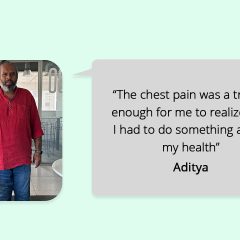 As mentioned in the previous article of Healthy Recipes For Kids, We spoke about the aspects of healthy eating for children not being different from adults. We need the right nutrients in the right quantities. Here, we’ve got some healthy recipes for a snack and a sweet that we’re sure your child will enjoy.
As mentioned in the previous article of Healthy Recipes For Kids, We spoke about the aspects of healthy eating for children not being different from adults. We need the right nutrients in the right quantities. Here, we’ve got some healthy recipes for a snack and a sweet that we’re sure your child will enjoy.
Healthy Recipes For Kids
1. Healthy Mathari
 What you will need:
What you will need:
- Wheat flour – 200 gm
- Roasted Gram flour – 50 gm
- Amaranth seed flour – 50 gm
- Semolina – 20 gm
- Desi ghee – 4 tbsp
- Salt – a per taste
- Dry fenugreek leaves – ½ tsp
- Asafetida (Hing) – 1/4th tsp
- Roasted Muskmelon seeds powder – 2 tsp
- Roasted Sunflower seeds powder – 2 tsp
- Carom seeds – 1 tsp
Method of preparation:
- Mix all the ingredients in a big bowl and add hot melted ghee. Gently mix all the ingredients until ghee spreads all over the flour.
- Knead the dough with lukewarm milk to provide a soft texture
- Keep it aside for half an hour.
- Roll out a big chapati and cut desired shapes with a cookie cutter as it appeals to kids.
- These Mathari or salted cookies can be baked or fried on a low flame.
- These serve as a good snack at the evening hours with milk, juices or smoothies.
2. Jaggery Protein Chikki/Laddoo
 What you will need:
What you will need:
- Almonds – 50 gm
- Walnuts – 50 gm
- Sunflower seeds – 20 gm
- Pumpkin seeds – 20 gm
- Muskmelon seeds – 20 gm
- Fox nuts – 50 gm
- Rolled oats – 30 gm
- Dates – 6-7 in number
- Jaggery – 200 gm
- White pepper powder – ½ tsp
- Poppy seeds – 30 gm
Method of preparation
- Roast all the ingredients separately without jaggery, dates & pepper powder
- Make a coarse powder by adding dates
- Melt jaggery on low flame. Once melted, start adding the white pepper powder
- Mix all ingredients gently
- Ladoos can be rolled from this mixture on slight cooling or chikki can be made by spreading the mixture on greased plate.
- These high protein chikkis or ladoos can be combined with breakfast or the evening snack
Benefits of These Recipes
- These matharis are rich in protein and contain seeds. Seeds are a compact source of many nutrients and generally kids don’t want to eat these seeds, so this is an easier way to get your kids to eat them.
- Jaggery laddoo or chikki is a power pack compact source of many nutrients, rich in protein, iron and white pepper powder is very good for the eyes.
- These snacks are much much better than the usual chips, mixtures and other unhealthy snacks.
We hope you enjoy these Healthy Recipes For Kids. Do try them out, upload your pics on social media or the GOQii Arena and tag us! For more healthy recipes, check out Healthy Reads or tune in to cooking sessions on GOQii Play.
To get more advice on recipes, nutrition and diet tips for kids, subscribe to GOQii and ask your GOQii Coach here.
#BeTheForce
 Overtraining, in essence, is performing excessive training which your body is unable to recover from – both in and outside the gym. The less severe versions of overtraining may take you a week to recover from. While most fitness experts will tell you that overtraining is worse than undertraining, some people still choose to push themselves which result in alarming physical and psychological effects.
Overtraining, in essence, is performing excessive training which your body is unable to recover from – both in and outside the gym. The less severe versions of overtraining may take you a week to recover from. While most fitness experts will tell you that overtraining is worse than undertraining, some people still choose to push themselves which result in alarming physical and psychological effects.  Can you imagine a plate of food without grains? It has been a staple for us since forever! There’s always that crushing sense of dissatisfaction if grain-based foods are missing from our plates even for a single day. As a large component of our diet for the longest time, why is it that most people are now moving towards a ‘no grains’ diet or keeping it to a minimum? One of the reasons people avoid grains is due to digestive issues – common ones being acid reflux, bloating, gas, abdominal cramps, flatulence, etc.
Can you imagine a plate of food without grains? It has been a staple for us since forever! There’s always that crushing sense of dissatisfaction if grain-based foods are missing from our plates even for a single day. As a large component of our diet for the longest time, why is it that most people are now moving towards a ‘no grains’ diet or keeping it to a minimum? One of the reasons people avoid grains is due to digestive issues – common ones being acid reflux, bloating, gas, abdominal cramps, flatulence, etc. Ever felt that burning sensation in your chest after a big meal or when you eat after a long gap? That feeling is known as acid reflux. Acid reflux is a condition where the acid content of the stomach flows up to the esophagus and pushes the food out from the mouth.
Ever felt that burning sensation in your chest after a big meal or when you eat after a long gap? That feeling is known as acid reflux. Acid reflux is a condition where the acid content of the stomach flows up to the esophagus and pushes the food out from the mouth.


